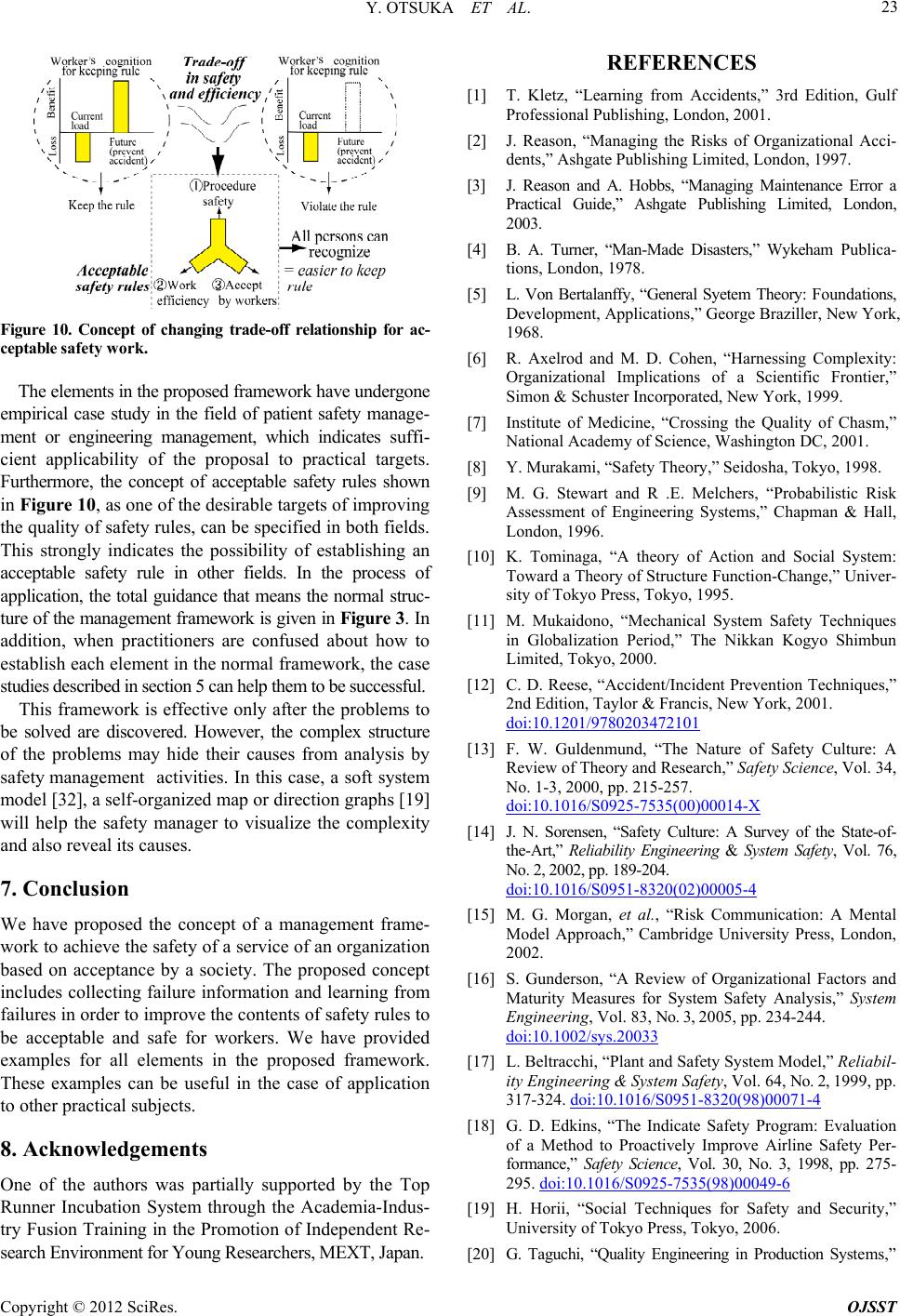
Y. OTSUKA ET AL. 23
s s
Figure 10. Concept of changing trade-off relationship for ac-
ceptable safety work.
The elements in the proposed framework have undergone
empirical case study in the field of patient safety manage-
ment or engineering management, which indicates s
cient applicability of the proposal to practical tar ets.
ules, can be specified in both fiel
Th
he contents of safety ru
fe for workers. We have provide
lements in the proposed framework.
[1] T. Kletz, “Lm Accidents,” 3rd Edition, Gulf
Professional Publishing, London, 2001.
[2] J. Reason, “MAcci-
dents,” Ashgate Publishing Limited, London, 1997.
na
Practical Guimited, London,
de Disasters,” Wykeham Publica-
l Syetem Theory: Foundations,
uffi- [7] Institute of Medicine, “Crossing the Quality of Chasm,”
National Academy of Science, Washington DC, 2001.
g
hown Furthermore, the concept of acceptable safety rules s
in Figure 10, as one of the desirable targets of improving
the quality of safety rds. Assessment of Engineering Systems,” Chapman & Hall,
London, 1996.
[10] K. Tominaga, “A theory of Action and Social System:
is strongly indicates the possibility of establishing an
acceptable safety rule in other fields. In the process of
application, the total guidance that means the normal struc-
ture of the management framework is given in Figure 3. In
addition, when practitioners are confused about how to
establish each element in the normal framework, the case
studies described in section 5 can help them to be successful.
This framework is effective only after the problems to
be solved are discovered. However, the complex structure
of the problems may hide their causes from analysis by
safety management activities. In this case, a soft system
model [32], a self-organized map or direction graphs [19]
will help the safety manager to visualize the complexity
and also reveal its causes.
7. Conclusion
We have proposed the concept of a management frame-
work to achieve the safety of a service of an organization
based on acceptance by a society. The proposed concept
includes collecting failure information and learning from
failures in order to improve tles to
d
be acceptable and sa
examples for all e
These examples can be useful in the case of application
to other practical subjects.
8. Acknowledgements
One of the authors was partially supported by the Top
Runner Incubation System through the Academia-Indus-
try Fusion Training in the Promotion of Independent Re-
search Environment for Young Researchers, MEXT, Japan.
2003.
[4] B. A. Turner, “Man-Ma
REFERENCES
earning fro
anaging the Risks of Organizational
[3] J. Reason ad A. Hobbs, “Managing Maintenance Error
de,” Ashgate Publishing Li
tions, London, 1978.
[5] L. Von Bertalanffy, “Genera
Development, Applications,” George Braziller, New York,
1968.
[6] R. Axelrod and M. D. Cohen, “Harnessing Complexity:
Organizational Implications of a Scientific Frontier,”
Simon & Schuork, 1999. ster Incorporated, New Y
[8] Y. Murakami, “Safety Theory,” Seidosha, Tokyo, 1998.
[9] M. G. Stewart and R .E. Melchers, “Probabilistic Risk
Toward a Theory of Structure Function-Change,” Univer-
sity of Tokyo Press, Tokyo, 1995.
[11] M. Mukaidono, “Mechanical System Safety Techniques
in Globalization Period,” The Nikkan Kogyo Shimbun
Limited, Tokyo, 2000.
[12] C. D. Reese, “Accident/Incident Prevention Techniques,”
2nd Edition, Taylor & Francis, New York, 2001.
doi:10.1201/9780203472101
[13] F. W. Guldenmund, “The Nature of Safety Culture: A
Review of Theory and Research,” Safety Science, Vol. 34,
No. 1-3, 2000, pp. 215-257.
doi:10.1016/S0925-7535(00)00014-X
[14] J. N. Sorensen, “Safety Culture: A Survey of the State-of-
the-Art,” Reliability Engineering & System Safety, Vol. 76,
No. 2, 2002, pp. 189-204.
doi:10.1016/S0951-8320(02)00005-4
[15] M. G. Morgan, et al., “Risk Communication: A Mental
Model Approach,” Cambridge University Press, London,
System Safety Analysis,” System
2002.
[16] S. Gunderson, “A Review of Organizational Factors and
Maturity Measures for
Engineering, Vol. 83, No. 3, 2005, pp. 234-244.
doi:10.1002/sys.20033
[17] L. Beltracchi, “Plant and Safety System Model,” Reliabil-
ity Engineering & System Safety, Vol. 64, No. 2, 1999, pp.
317-324. doi:10.1016/S0951-8320(98)00071-4
[18] G. D. Edkins, “The Indicate S
of a Method to Proactively Improve A
afety Program: Evaluation
irline Safety Per-
formance,” Safety Science, Vol. 30, No. 3, 1998, pp. 275-
295. doi:10.1016/S0925-7535(98)00049-6
[19] H. Horii, “Social Techniques
University of Tokyo Press, Tokyo, 200
for Safety and Security,”
6.
[20] G. Taguchi, “Quality Engineering in Production Systems,”
Copyright © 2012 SciRes. OJSST